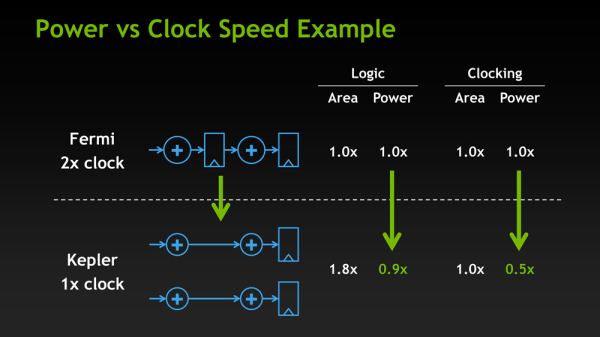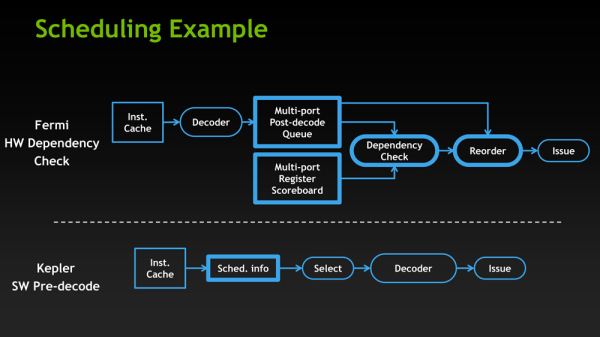NVIDIA GeForce GTX 680 Review: Retaking The Performance Crown
by Ryan Smith on March 22, 2012 9:00 AM ESTThe Kepler Architecture: Efficiency & Scheduling
So far we’ve covered how NVIDIA has improved upon Fermi for; now let’s talk about why.
Mentioned quickly in our introduction, NVIDIA’s big push with Kepler is efficiency. Of course Kepler needs to be faster (it always needs to be faster), but at the same time the market is making a gradual shift towards higher efficiency products. On the desktop side of matters GPUs have more or less reached their limits as far as total power consumption goes, while in the mobile space products such as Ultrabooks demand GPUs that can match the low power consumption and heat dissipation levels these devices were built around. And while strictly speaking NVIDIA’s GPUs haven’t been inefficient, AMD has held an edge on performance per mm2 for quite some time, so there’s clear room for improvement.
In keeping with that ideal, for Kepler NVIDIA has chosen to focus on ways they can improve Fermi’s efficiency. As NVIDIA's VP of GPU Engineering, Jonah Alben puts it, “[we’ve] already built it, now let's build it better.”
There are numerous small changes in Kepler that reflect that goal, but of course the biggest change there was the removal of the shader clock in favor of wider functional units in order to execute a whole warp over a single clock cycle. The rationale for which is actually rather straightforward: a shader clock made sense when clockspeeds were low and die space was at a premium, but now with increasingly small fabrication processes this has flipped. As we have become familiar with in the CPU space over the last decade, higher clockspeeds become increasingly expensive until you reach a point where they’re too expensive – a point where just distributing that clock takes a fair bit of power on its own, not to mention the difficulty and expense of building functional units that will operate at those speeds.
With Kepler the cost of having a shader clock has finally become too much, leading NVIDIA to make the shift to a single clock. By NVIDIA’s own numbers, Kepler’s design shift saves power even if NVIDIA has to operate functional units that are twice as large. 2 Kepler CUDA cores consume 90% of the power of a single Fermi CUDA core, while the reduction in power consumption for the clock itself is far more dramatic, with clock power consumption having been reduced by 50%.
Of course as NVIDIA’s own slide clearly points out, this is a true tradeoff. NVIDIA gains on power efficiency, but they lose on area efficiency as 2 Kepler CUDA cores take up more space than a single Fermi CUDA core even though the individual Kepler CUDA cores are smaller. So how did NVIDIA pay for their new die size penalty?
Obviously 28nm plays a significant part of that, but even then the reduction in feature size from moving to TSMC’s 28nm process is less than 50%; this isn’t enough to pack 1536 CUDA cores into less space than what previously held 384. As it turns out not only did NVIDIA need to work on power efficiency to make Kepler work, but they needed to work on area efficiency. There are a few small design choices that save space, such as using 8 SMXes instead of 16 smaller SMXes, but along with dropping the shader clock NVIDIA made one other change to improve both power and area efficiency: scheduling.
GF114, owing to its heritage as a compute GPU, had a rather complex scheduler. Fermi GPUs not only did basic scheduling in hardware such as register scoreboarding (keeping track of warps waiting on memory accesses and other long latency operations) and choosing the next warp from the pool to execute, but Fermi was also responsible for scheduling instructions within the warps themselves. While hardware scheduling of this nature is not difficult, it is relatively expensive on both a power and area efficiency basis as it requires implementing a complex hardware block to do dependency checking and prevent other types of data hazards. And since GK104 was to have 32 of these complex hardware schedulers, the scheduling system was reevaluated based on area and power efficiency, and eventually stripped down.
The end result is an interesting one, if only because by conventional standards it’s going in reverse. With GK104 NVIDIA is going back to static scheduling. Traditionally, processors have started with static scheduling and then moved to hardware scheduling as both software and hardware complexity has increased. Hardware instruction scheduling allows the processor to schedule instructions in the most efficient manner in real time as conditions permit, as opposed to strictly following the order of the code itself regardless of the code’s efficiency. This in turn improves the performance of the processor.
However based on their own internal research and simulations, in their search for efficiency NVIDIA found that hardware scheduling was consuming a fair bit of power and area for few benefits. In particular, since Kepler’s math pipeline has a fixed latency, hardware scheduling of the instruction inside of a warp was redundant since the compiler already knew the latency of each math instruction it issued. So NVIDIA has replaced Fermi’s complex scheduler with a far simpler scheduler that still uses scoreboarding and other methods for inter-warp scheduling, but moves the scheduling of instructions in a warp into NVIDIA’s compiler. In essence it’s a return to static scheduling.
Ultimately it remains to be seen just what the impact of this move will be. Hardware scheduling makes all the sense in the world for complex compute applications, which is a big reason why Fermi had hardware scheduling in the first place, and for that matter why AMD moved to hardware scheduling with GCN. At the same time however when it comes to graphics workloads even complex shader programs are simple relative to complex compute applications, so it’s not at all clear that this will have a significant impact on graphics performance, and indeed if it did have a significant impact on graphics performance we can’t imagine NVIDIA would go this way.
What is clear at this time though is that NVIDIA is pitching GTX 680 specifically for consumer graphics while downplaying compute, which says a lot right there. Given their call for efficiency and how some of Fermi’s compute capabilities were already stripped for GF114, this does read like an attempt to further strip compute capabilities from their consumer GPUs in order to boost efficiency. Amusingly, whereas AMD seems to have moved closer to Fermi with GCN by adding compute performance, NVIDIA seems to have moved closer to Cayman with Kepler by taking it away.
With that said, in discussing Kepler with NVIDIA’s Jonah Alben, one thing that was made clear is that NVIDIA does consider this the better way to go. They’re pleased with the performance and efficiency they’re getting out of software scheduling, going so far to say that had they known what they know now about software versus hardware scheduling, they would have done Fermi differently. But whether this only applies to consumer GPUs or if it will apply to Big Kepler too remains to be seen.












404 Comments
View All Comments
blppt - Thursday, March 22, 2012 - link
Wondering if you guys could also add a benchmark for one the current crop of 1ghz core 7970s that are available now (if you've tested any). Otherwise, great review.tipoo - Thursday, March 22, 2012 - link
With everything being said by Nvidia, I thought this would be a Geforce 8k series class jump, while its really nothing close to that and trades blows with AMDs 3 month old card. GCN definitely had headroom so I can see lower priced, higher clocked AMD cards coming out soon to combat this. Still, I'm glad this will bring things down to sane prices.MarkusN - Thursday, March 22, 2012 - link
Well to be honest, this wasn't supposed to be Nvidias successor to the GTX 580 anyway. This graphics card replaced the GTX 560 Ti, not the GTX 580. GK 110 will replace the GTX 580, even if you can argue that the GTX 680 is now their high-end card, it's just a replacement for the GTX 560 Ti so I can just dream about the performance of the GTX 780 or whatever they're going to call it. ;)tipoo - Thursday, March 22, 2012 - link
I didn't know that, thanks. Ugh, even more confusing naming schemes.Articuno - Thursday, March 22, 2012 - link
If this is supposed to replace the 560 Ti then why does it cost $500 and why was it released before the low-end parts instead of before the high-end parts?MarkusN - Thursday, March 22, 2012 - link
It costs that much because Nvidia realized that it outperforms/trades blows with the HD 7970 and saw an opportunity to make some extra cash, which basically sucks for us consumers. There are those that say that the GTX 680 is cheaper and better than the HD 7970 and think it costs just the right amount, but as usual it's us, the customers, that are getting the shaft again. This card should've been around $300-350 in my opinion, no matter if it beats the HD 7970.coldpower27 - Thursday, March 22, 2012 - link
Nah, they aren't obligated to give more then what the market will bear, no sense in starting a price war when they can have much fatter margins, it beats the 7970 already it's just enough.Now the ball is in AMD's court let's see if they can drop prices to compete $450 would be a nice start, but $400 is necessary to actually cause significant competition.
CeriseCogburn - Friday, March 23, 2012 - link
This whole thing is so nutso but everyone is saying it.Let's take a thoughtful sane view...
The GTX580 flagship was just $500, and a week or two ago it was $469 or so.
In what world, in what release, in the past let's say ten years even, has either card company released their new product with $170 or $200 off their standard flagship price when it was standing near $500 right before the release ?
The answer is it has never, ever happened, not even close, not once.
With the GTX580 at $450, there's no way a card 40% faster is going to be dropped in at $300, no matter what rumor Charlie Demejerin at Semi0-Accurate has made up from thin air up as an attack on Nvidia, a very smart one for not too bright people it seems.
Please, feel free to tell me what flagship has ever dropped in cutting nearly $200 off the current flagship price ?
Any of you ?!?
Lepton87 - Thursday, March 22, 2012 - link
Because nVidia decided to screw its costumer and nickle and dime them. That's why. All because 7970 underperformed and nv could get away with it.JarredWalton - Thursday, March 22, 2012 - link
Or: Because NVIDIA and AMD and Intel are all businesses, and when you launch a hot new product and lots of people are excited to get one, you sell at a price premium for as long as you can. Then supply equals demand and then exceeds demand and that's when you start dropping prices. 7970 didn't underperform; people just expected/wanted more. Realistically, we're getting to the point where doubling performance with a process shrink isn't going to happen, and even 50% improvements are rare. 7970 and 680 are a reflection of that fact.